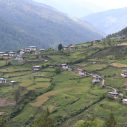
Search
Dominican Republic becomes first country in the Caribbean to launch a MPI

Photo: Vicepresidencia de República Dominicana
The Government of the Dominican Republic launched its Multidimensional Poverty Index (MPI) on June 27 in an official ceremony led by Vice President Margarita Cedeño Fernández and attended by a number of Government Ministers and Sabina Alkire, Director of OPHI. The Dominican Republic MPI has 5 dimensions with 24 indicators. Among them are the digital gap, discrimination and participation — all highly innovative. The data comes from a new instrument, the MPI Questionnaire, designed specifically to capture the different dimensions that had been identified through a participatory process.
The government presented the Dominican Republic’s Multidimensional Poverty Index (MPI-DR) on Tuesday, an innovative method of measuring the multiple factors that poor people experience at the same time, in order to design more focused and transparent public policies that respond to the needs of the people.

Lorenzo Jimenez, Resident Representative of the United Nations Development Program (UNDP); Margarita Cedeño, Vice President of the Republic; Sabina Alkire, director of the Oxford Poverty and Human Development Initiative (OPHI).
The launch of the new index was carried out in the Salón Las Cariátides, of the National Palace, in an event led by the Vice President of the Republic, Margarita Cedeño; together with the director of the Oxford Poverty and Human Development Initiative (OPHI), Sabina Alkire; the Resident Representative of the United Nations Development Program (UNDP), Lorenzo Jiménez de Luis; the director of the Single System of Beneficiaries (Siuben), Matilde Chávez; and the Minister of Economy, Planning and Development, Isidoro Santana.
The index, which is a complement to the official poverty measure estimated by income, will be applied to the database of the Single System of Beneficiaries (Siuben) through the Socioeconomic Study of Households 2017, which will be legally mandated in a period of two years. This process is supported by UNDP, the Inter-American Development Bank (IDB) and the World Bank (WB).
For Vice President Margarita Cedeño said: “The MPI-DR adapts itself to each reality and allows us to analyse poverty from other perspectives that have not been taken into account so far in the country, studying in greater depth factors related to human well-being, health, the digital divide, citizen security, environment and surroundings among others.”
UNDP representative Lorenzo Jiménez de Luis stated that “the Sustainable Development Agenda 2030 recognizes that addressing the issue of development as a multi-dimensional process is indispensable for sustainably overcoming the problem of poverty. That is why the generation of multidimensional poverty indices, such as the one that the Dominican Republic launches today, is becoming increasingly relevant for the design of integrated interventions that respond to the different spheres of human development. ”
The Dominican Republic MPI will be available for use by public institutions so that they can adjust and improve their public policies which will facilitate direct tracking of the variables that characterise poverty, highlighting advances made.
Functions of the IPM-RD
The Dominican Republic is also part of the Global MPI that is calculated every year by OPHI. The Global MPI makes it possible to compare multidimensional poverty across countries. The Dominican Republic is part as well of the IPM-Latin America developed by the Economic Commission for Latin America and the Caribbean (ECLAC), with OPH that allows the Dominican Republic to measure its performance along side that of its neighbors. But now the country will have its own National IPM-RD, to analyze the situation in which Dominicans live and to develop more efficient and effective public policies.
The index measures five critical dimensions at the individual level that reveal not only how many people are multidimensionally poor, but also the composition and intensity of their poverty, considering that poverty is not just lack of money. The MPI-DR directly calculates deprivations in Health, Education and Child Care, Livelihood and Labor; Housing and Environment; Digital Gap and Social Relationships. Public primary services such as water, electricity and sanitation are also measured by this innovative index.
Measuring poverty from a multidimensional perspective will make monitoring much easier for authorities which will allow better identification of vulnerable groups and permit better targeting for public policy and interventions.
















